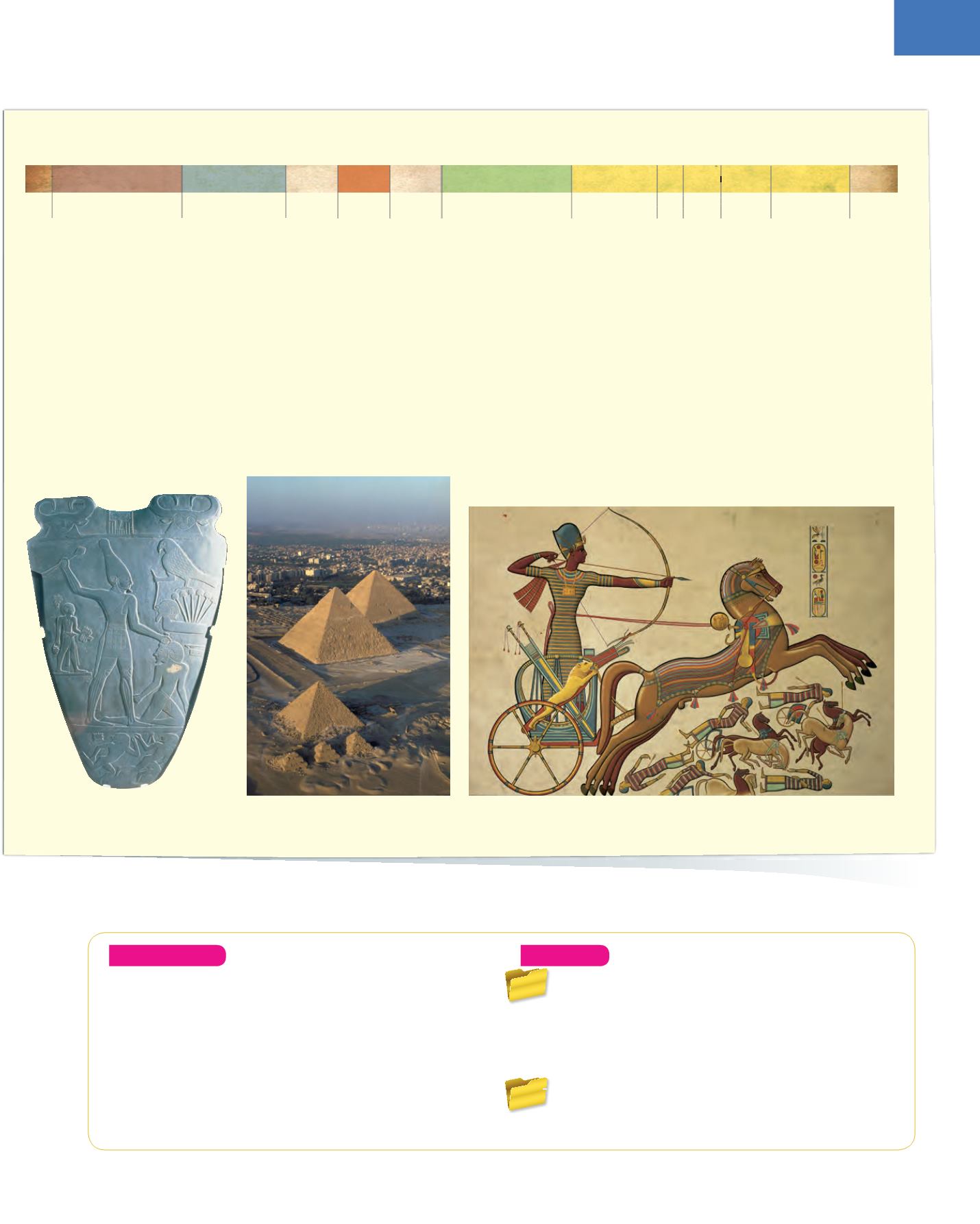
3
3. The first civilisations
55
THE HISTORICAL DEVELOPMENT OF ANCIENT EGYPT
The
Narmer Palette.
The first king of
unified Egypt hits enemies.
Ramesses II in his blue war crown at the Battle of Kadesh. Illustration
inspired by the relief from the Great Temple of Abu Simbel.
3100 B.C.
2600 B.C.
2200 B.C. 2000 B.C. 1800 B.C. 1600 B.C.
1100 B.C.
770 B.C. 670 B.C. 525 B.C. 332 B.C.
E
ARLY
D
YNASTIC
P
ERIOD
30 B.C.
O
LD
K
INGDOM
M
IDDLE
K
INGDOM
N
EW
K
INGDOM
P
ERSIANS
A
SSYRIANS
G
REEKS
R
OMANS
L
ATE
P
ERIOD
N
UBIANS
The pyramids of Khufu, Khafre and
Menkaure in Giza, near Cairo
In the Early Dynastic Period,
there was the first unification.
During the
Old Kingdom
the
capital was established
in
Memphis
. The first work of
this period of Egyptian history
was the building of the pyramids
of the pharaohs Khufu, Khafra
and Menkaure, near the capital.
The Old Kingdom ended due
to a series of internal rebellions
and battles among the
nomarchs.
In the 21st century B.C., Egypt
became unified again, marking
the beginning of the
Middle
Kingdom
. The capital was
moved to
Thebes
and the
kingdom expanded to the lands
of the south (
Nubia
).
This period came to an end when
Egypt was invaded by an Asiatic
people, the Hyksos. These people
created their own dynasties and
established their capital in Avaris
in the Nile delta.
The
New Kingdom
began when
the pharaoh of Thebes expelled
the Hyksos. The rulers of this
period were Queen Hatshepsut
and the pharaohs Akhenaten
(Amenophis IV) and his queen
Nefertiti, Tutankhamun,
Ramesses II (who was famous
for fighting against the Hittites
at the Battle of Kadesh, Syria)
and Ramesses III (who defeated
the Sea Peoples when they tried
to invade Egypt). The pharaohs
were buried in the Valley of the
Kings.
During the
Late Kingdom
, Egypt
broke up and was invaded by the
Nubians, Assyrians and Persians.
In 332 B.C., it was conquered
by the Macedonian Alexander
the Great and governed by the
Ptolemaic Dynasty. Egyptian
culture mixed with Greek culture
and the capital was moved to
Alexandria
. Cleopatra VII was
the last queen of Egypt. In 30
B.C. Egypt became a Roman
province.
Understand
19.
Look at the timeline on this page. How many years
passed between the first unification of Egypt and the
conquest by Rome?
20.
What type of crown is the king wearing in the
Narmer Palette?
What does the man kneeling at his
feet symbolise? What similarities and differences
are there between this image, the representation
Ramesses II and the
Stele of Naram-Sin?
Analyse
21.
Draw a map in your notebook or print a
map of
Ancient Egypt
. Mark the territory occupied by
Upper and Lower Egypt and the important cities.
22.
Compare the positions of pharaoh in Egypt and
patesi
in Sumer. How are they different?
23.
Copy the timelines of Mesopotamia and Ancient
Egypt into your notebook. Compare them and
write a short essay explaining your conclusions.


